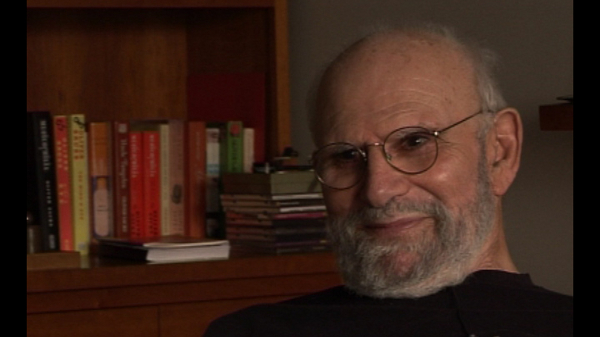NEXT STORY

Uncle Tungsten: I want my work delivered in full, not in excerpts
RELATED STORIES

NEXT STORY

Uncle Tungsten: I want my work delivered in full, not in excerpts
RELATED STORIES


|
Views | Duration | |
|---|---|---|---|
| 271. The second half of Uncle Tungsten: inspiration and... | 193 | 03:11 | |
| 272. Uncle Tungsten: I want my work delivered in full, not... | 181 | 01:30 | |
| 273. My handsome mug | 1 | 268 | 01:10 |
| 274. My love of Kew Gardens | 246 | 01:10 | |
| 275. The Sense of Movement by Thom Gunn | 326 | 02:08 | |
| 276. Thom Gunn's comments on my writing style | 256 | 01:44 | |
| 277. A scary first experience of steep Filbert Street, San Francisco | 211 | 01:14 | |
| 278. My last meeting with Thom Gunn and his death | 1 | 540 | 03:59 |
| 279. Thom Gunn's unique style of poetry | 312 | 01:34 | |
| 280. Thom Gunn was an excellent teacher | 256 | 00:53 |


But I spoke of cross-currents, and one day, when I was in the zócalo, or the central square, of Oaxaca city, I got a bus back to the hotel and there were two people on the bus who were speaking... a dialect of German, a sort of Swiss Deutsch. And this immediately brought to mind how, in 1946, just after the war, my… well, of course, '45 would have been just after the war, but in '46… take that parenthesis out, I’m wrong... how in '46, just after the war, my parents went and took me and my brother Michael to Switzerland, and how we had been picked up at the railway station by an electric vehicle and how I heard people speaking this Swiss Deutsch. So, suddenly I remembered this forgotten incident of arriving at Lucerne when I was 13 in 1946. And this in itself insignificant thing then opened out into many of the personal aspects of childhood and boyhood and growing up, and this led to the other half, the personal half, of Uncle Tungsten. So Uncle Tungsten… I’ve spoken of the Island of the Colourblind as a double book. In another sense, Uncle Tungsten is a double book. But here the two parts are ‘Siamesed’ together. They... they are both me. And it’s me, and chemistry, and growing up, and London, and family, and being Jewish, and being neurotic, and being exiled to a school in the country, and going a little mad. It’s all there. It’s all in Uncle Tungsten.
And so this was a radical departure for me. This was a... an autobiography, a memoir, hinted at by the two pieces I had written in 1993, the Humphry Davy piece and the South Kensington Museums piece. It gave me great joy, although I shouldn’t conceal the fact there were also great difficulties, but there was great joy writing Uncle Tungsten, although just as the rare earth metals had to be cut down from 50,000 words to 500, so the manuscript was almost a 1,000,000 words and was cut down to 100,000.
Oliver Sacks (1933-2015) was born in England. Having obtained his medical degree at Oxford University, he moved to the USA. There he worked as a consultant neurologist at Beth Abraham Hospital where in 1966, he encountered a group of survivors of the global sleepy sickness of 1916-1927. Sacks treated these patients with the then-experimental drug L-Dopa producing astounding results which he described in his book Awakenings. Further cases of neurological disorders were described by Sacks with exceptional sympathy in another major book entitled The Man Who Mistook His Wife For A Hat which became an instant best seller on its publication in 1985. His other books drew on his rich experiences as a neurologist gleaned over almost five decades of professional practice. Sacks's work was recognized by prestigious institutions which awarded him numerous honours and prizes. These included the Lewis Thomas Prize given by Rockefeller University, which recognizes the scientist as poet. He was an honorary fellow of both the American Academy of Arts and Letters and the American Academy of Arts and Sciences, and held honorary degrees from many universities, including Oxford, the Karolinska Institute, Georgetown, Bard, Gallaudet, Tufts, and the Catholic University of Peru.
Title: The second half of "Uncle Tungsten": inspiration and writing
Listeners: Kate Edgar
Kate Edgar, previously Managing Editor at the Summit Books division of Simon and Schuster, began working with Oliver Sacks in 1983. She has served as editor and researcher on all of his books, and has been closely involved with various films and adaptations based on his work. As friend, assistant, and collaborator, she has accompanied Dr Sacks on many adventures around the world, clinical and otherwise.
Tags: Uncle Tungsten, Oaxaca, Lucerne, Island of the Colourblind, Jewish, Oaxaca Journal, Humphry Davy
Duration: 3 minutes, 11 seconds
Date story recorded: September 2011
Date story went live: 02 October 2012